Hindu architecture
Hindu architecture is a traditional Hindu system of temple architecture, monasteries, mausoleums and other architectural religious buildings of Hinduism. The science of Hindu architecture (principles and standards, where and how temples should be built, design rules) in India is described in Hindu texts — Vastu shastra (Manasara etc), and Shilpa Shastras deal with forming statues, icons, stone murals, painting and others.[1][2] Due to Islamic conquests in the Middle Ages, many ancient Hindu buildings were destroyed.[3]
By far the most important, characteristic and numerous examples of Hindu architecture are Hindu temples, with an architectural tradition that has left surviving examples in stone, brick, and rock-cut architecture dating back to the Gupta Empire. These drew on earlier Buddhist (and to some extent Jain) religious architecture, but Hindu temples were shaped by their rather different religious requirements, which in essence have remained unchanged since the earliest period.
There is far less secular architecture that can really be called "Hindu" rather than "Indian". Very little early palace architecture survives, and the great majority of surviving palaces show clear influence from Indo-Islamic architecture, especially Mughal architecture, later joined by European architecture. The same is true of most samadhi, tombs or mausoleums, generally only built for ruling families or important religious figures. Burial by interment rather than cremation has traditionally been unusual in Hinduism, and elaborate memorial buildings are a custom largely influenced by Islamic examples.
Temples (mandirs)

Hindu temple architecture has many varieties of style, though the basic nature of the Hindu temple ("mandir") remains the same, with the essential feature an inner sanctum, the garbha griha or womb-chamber, where the primary murti or the image of a deity is housed in a simple bare cell. Around this chamber there are often other structures and buildings, in the largest cases covering several acres. On the exterior, the garbhagriha is crowned by a tower-like shikhara, also called the vimana in the south. The shrine building often includes an ambulatory for parikrama (circumambulation), a mandapa congregation hall, and sometimes an antarala antechamber and porch between garbhagriha and mandapa. There may further mandapas or other buildings, connected or detached, in large temples, together with other small temples in the compound.[4] There are examples of special dance pavilions (Nata Mandir), like in the Konark Sun Temple. The pool, temple tank (Kunda) is also part of the temple for ablutions.[5]
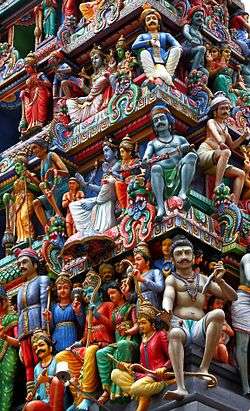
Monasteries (mathas)
Hindu monasteries such as Mathas and hermitages (Ashrams) are complexes of buildings include temples, monastic cells or the communal house and ancillary facilities[7]. In some currents of Hinduism, places of pilgrimage have become Bhajana Kutir, viz., meditation huts of the saints.
Tombs (samadhis)
Samadhi (shrine) is a tomb (mausoleum) which may or may not contain the body of the deceased. Samadhi sites are often built in this way to honor people regarded as saints.[8]
Rathas
In some Hindu sites, there are shrines or buildings named rathas because they have the shape of a huge chariot.[9]
Toranas (archways)
Torana is a free-standing archway for ceremonial purposes seen in the Hindu, Buddhist and Jain architecture in front of the temples, monasteries and other objects, sometimes as single building.[10][11]
Stambhas (columns)
Stambha is used in the context of Hinduism and Jainism to denote pillar or column[12], e. g. dedicated to Vishnu «Tower of victory» (Vijay Stambha) at Chittorgarh fort, Rajasthan.
«Dhvaja-stambhas» are founding at the entrance of temples as flagstaffs, often with the image of lingam and sacred animals.
Chhatris
Chhatris are elevated, dome-shaped pavilions used as an element in Indian architecture, originating in Rajasthani architecture. They are widely used in palaces, in forts, or to demarcate funerary sites, etc.
Ghats
Ghat is a series of steps leading down to a body of water, particularly a holy river or lake.
Goshalas
Goshalas are protective shelters for cows as sacred animals in India. Goshalas focus on treating cows well, because of their religious significance in Hinduism and consequent cultural sensitivity towards their welfare. There is the abode or sanctuary for cows, calves and oxen.[13]
Gallery
 Cave Kailasa temple, Ellora (Maharashtra)
Cave Kailasa temple, Ellora (Maharashtra) Lingaraja Temple (Bhubaneswar, Odisha)
Lingaraja Temple (Bhubaneswar, Odisha) Chennakeshava Temple, Belur (Karnataka)
Chennakeshava Temple, Belur (Karnataka) Lalji temple (Bishnupur, Bankura, West Bengal)
Lalji temple (Bishnupur, Bankura, West Bengal) Nallur Kandaswamy temple (Sri Lanka)
Nallur Kandaswamy temple (Sri Lanka).jpg)
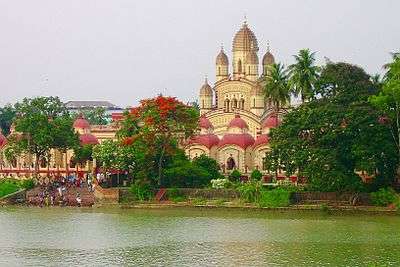 Dakshineswar Kali Temple with Ghat (Kolkata)
Dakshineswar Kali Temple with Ghat (Kolkata) Nata Mandir of Konark Sun Temple (Odisha)
Nata Mandir of Konark Sun Temple (Odisha) Meenakshiamman Temple Gopuram (Madurai, Tamil Nadu)
Meenakshiamman Temple Gopuram (Madurai, Tamil Nadu) Ranganathaswamy Temple, Srirangam Gopuram (Tamil Nadu)
Ranganathaswamy Temple, Srirangam Gopuram (Tamil Nadu)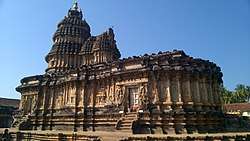 Advaita Vedanta Monastery (Sringeri, Karnataka)
Advaita Vedanta Monastery (Sringeri, Karnataka)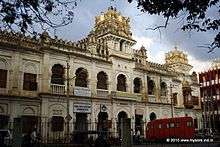 Parakala Matha (Mysore, Karnataka)
Parakala Matha (Mysore, Karnataka)
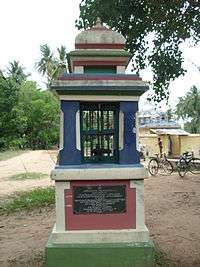 Appayya Dikshitar's Samadhi (Thiruvalangadu, Tamil Nadu)
Appayya Dikshitar's Samadhi (Thiruvalangadu, Tamil Nadu) Bhaktiprajnana Kesava's Samadhi in Devananda Gaudiya Math (Nabadwip)
Bhaktiprajnana Kesava's Samadhi in Devananda Gaudiya Math (Nabadwip)- Prabhupada's Samadhi with Chhatris (Mayapur, West Bengal)
 Pancha Rathas (Mahabalipuram, Tamil Nadu)
Pancha Rathas (Mahabalipuram, Tamil Nadu) Ratha (Garuda shrine) (Hampi, Karnataka)
Ratha (Garuda shrine) (Hampi, Karnataka)Torana.jpg) Sahastra Bahu Temples Torana (Nagda, Rajasthan)
Sahastra Bahu Temples Torana (Nagda, Rajasthan) Torana of Mukteshvara Temple, Bhubaneswar (Orisha)
Torana of Mukteshvara Temple, Bhubaneswar (Orisha) Devananda Gaudiya Math Torana (Nabadwip, West Bengal)
Devananda Gaudiya Math Torana (Nabadwip, West Bengal) Heliodorus pillar (Vidisha, Madhya Pradesh)
Heliodorus pillar (Vidisha, Madhya Pradesh)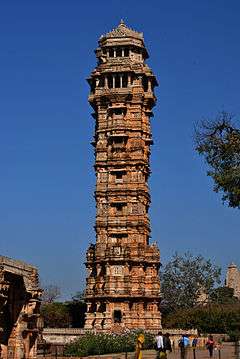 Vijay Stambha at Chittorgarh fort (Rajasthan)
Vijay Stambha at Chittorgarh fort (Rajasthan) Srimukhalingeswara temple Dhvaja-stambha Mukhalingam, Andhra Pradesh)
Srimukhalingeswara temple Dhvaja-stambha Mukhalingam, Andhra Pradesh)- Thirunakkara Sree Mahadevar Temple, Kottayam Dhvaja-stambha (Kerala)
- Mandapa and Stambhas of Chennakeshava Temple, Belur (Karnataka)
 Chhatris (Pushkar Lake, Rajasthan)
Chhatris (Pushkar Lake, Rajasthan)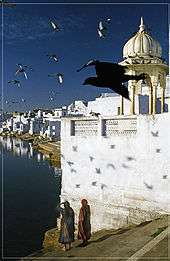 Chhatris and Ghats (Pushkar Lake, Rajasthan)
Chhatris and Ghats (Pushkar Lake, Rajasthan) Ghat in Varanasi (Uttar Pradesh)
Ghat in Varanasi (Uttar Pradesh)- Ghats on Narmada River (Maheshwar, Madhya Pradesh)
 Ghat on Narmada River (Maheshwar, Madhya Pradesh)
Ghat on Narmada River (Maheshwar, Madhya Pradesh)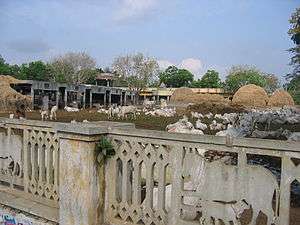 Goshala at Guntur (Andhra Pradesh)
Goshala at Guntur (Andhra Pradesh) Goshala at Udupi Sri Krishna Matha (Karnataka)
Goshala at Udupi Sri Krishna Matha (Karnataka)
See also
- Hindu temple architecture
- Indian rock-cut architecture
- Indian architecture
- Dravidian architecture
- Nagara architecture
References
- Acharya 1927.
- Shukla 1993.
- Goel 1991.
- Michell 1988.
- Acharya 2010, p. 74.
- "Gopura". Encyclopædia Britannica. Retrieved 2008-01-20.
- Sears 2014, pp. 4—9.
- Glushkova 2014, p. 116.
- Harle 1994, p. 153.
- "Toraṇa | Grove Art". doi:10.1093/gao/9781884446054.001.0001/oao-9781884446054-e-7000085631. Retrieved 2018-08-08.
- Dhar 2010.
- Acharya 2010, p. 533.
- "300 cattle head for goshala everyday". Times Of India. 2011-08-17. Retrieved 2013-02-06.
Bibliography
- Acharya, P. K. (2010). An encyclopaedia of Hindu architecture. New Delhi: Oxford University Press (Republished by Motilal Banarsidass). ISBN 81-85990-03-4.
- Acharya, P. K. (1927). Indian Architecture according to the Manasara Shilpa Shastra. London: Oxford University Press (Republished by Motilal Banarsidass). ISBN 0300062176.
- Dhar, P. D. (2010). The Torana in Indian and Southeast Asian Architecture. New Delhi: D K Printworld. ISBN 978-8124605349.
- Glushkova, I. (2014). Objects of Worship in South Asian Religions: Forms, Practices and Meanings. Routledge. ISBN 978-1-317-67595-2.
- Goel, S. R. (1991). Hindu Temples – What Happened to Them. 2. New Delhi: Voice of India. ISBN 81-85990-03-4.
- Harle, J. C. (1994). The Art and Architecture of the Indian Subcontinent (2nd ed.). Yale University Press Pelican History of Art. ISBN 0300062176.
- Juneja, M. (2001). Architecture in Medieval India: Forms, Contexts, Histories (2nd ed.). Orient Blackswan. ISBN 978-8178242286.
- Michell, G. (1988). The Hindu Temple: An Introduction to its Meaning and Forms (2nd ed.). Chicago/London: University of Chicago Press. ISBN 0-226-53230-5.
- Shukla, D. N. (1993). Vastu-Sastra: Hindu Science of Architecture. Munshiram Manoharial Publishers. ISBN 978-81-215-0611-3.
- Sears, T. (2014). Worldly Gurus and Spiritual Kings: Architecture and Asceticism in Medieval India. Yale University Press. ISBN 978-0-300-19844-7.
- Thapar, B. (2004). Introduction to Indian Architecture. Singapore: Periplus Editions. ISBN 0-7946-0011-5.
External links
| Wikimedia Commons has media related to Hindu buildings. |
- Vijayanagara architecture
- Sthapatyaveda (Temple Architecture) on Hindupedia, the Hindu Encyclopedia
